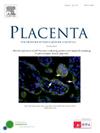Reduced SMEK1 regulates trophoblast migration and invasion in fetal growth restriction
IF 3
2区 医学
Q2 DEVELOPMENTAL BIOLOGY
引用次数: 0
Abstract
Introduction
Fetal growth restriction (FGR) is a significant pregnancy condition characterized by the fetus failing to attain its full genetic growth potential. FGR is primarily ascribed to defective placentation, owing to impaired trophoblast cellular function. The objective of this research is to elucidate the pathogenic functions of suppressor of Mek1 (SMEK1) in FGR.
Methods
Western blot and Immunofluorescence were used to detect the expression and localization of SMEK1 in placenta. We overexpressed and knocked down SMEK1 using plasmid or siRNA special targeted it. EdU Assay, flow cytometry, Western blot, Wound healing migration and Transwell insert assay were used to detect the influence of SMEK1 on cellular function. The mechanism of SMEK1 in regulating the migration of JEG3 cells was predicted by employing transcriptomics and bioinformatics analysis, and was validated by Western blot.
Results
The expression of SMEK1 was downregulated in FGR placentas. The aberrant expression of SMEK1 in JEG3 cells is associated with cell migration and invasion, but not with proliferation, or apoptosis. Transcriptomic analysis and Western blots indicate that knockdown of SMEK1 inhibited the PI3K/Akt/mTOR pathway. A significant inhibition was observed in the epithelial-mesenchymal transition (EMT) process of JEG3 cells within the SMEK1 knockdown group. The activation of the PI3K/Akt/mTOR pathway partially restored the impaired migration and invasive ability due to SMEK1 knockdown in JEG3 cells.
Discussion
the reduction of SMEK1 may contribute to the development of FGR by hindering the EMT process of trophoblast cells through modulation of the PI3K/Akt/mTOR signaling pathway.
在胎儿生长受限中,SMEK1的减少调节滋养细胞的迁移和侵袭
胎儿生长受限(FGR)是一种重要的妊娠状况,其特征是胎儿未能达到其全部遗传生长潜力。FGR主要归因于滋养细胞功能受损导致的胎盘缺陷。本研究旨在阐明Mek1抑制因子(SMEK1)在FGR中的致病功能。方法采用western blot和免疫荧光法检测胎盘组织中SMEK1的表达和定位。我们使用特异性靶向SMEK1的质粒或siRNA过表达和敲低SMEK1。采用EdU法、流式细胞术、Western blot、创面愈合迁移、Transwell插入法检测SMEK1对细胞功能的影响。通过转录组学和生物信息学分析预测SMEK1调控JEG3细胞迁移的机制,并通过Western blot验证。结果FGR胎盘中SMEK1表达下调。SMEK1在JEG3细胞中的异常表达与细胞迁移和侵袭有关,但与增殖或凋亡无关。转录组学分析和Western blot结果表明,敲低SMEK1可抑制PI3K/Akt/mTOR通路。在SMEK1敲低组中,观察到JEG3细胞的上皮-间质转化(EMT)过程明显受到抑制。PI3K/Akt/mTOR通路的激活部分恢复了JEG3细胞中由于SMEK1敲低而受损的迁移和侵袭能力。SMEK1的减少可能通过调节PI3K/Akt/mTOR信号通路阻碍滋养细胞的EMT过程,从而促进FGR的发展。
本文章由计算机程序翻译,如有差异,请以英文原文为准。
求助全文
约1分钟内获得全文
求助全文
来源期刊

Placenta
医学-发育生物学
CiteScore
6.30
自引率
10.50%
发文量
391
审稿时长
78 days
期刊介绍:
Placenta publishes high-quality original articles and invited topical reviews on all aspects of human and animal placentation, and the interactions between the mother, the placenta and fetal development. Topics covered include evolution, development, genetics and epigenetics, stem cells, metabolism, transport, immunology, pathology, pharmacology, cell and molecular biology, and developmental programming. The Editors welcome studies on implantation and the endometrium, comparative placentation, the uterine and umbilical circulations, the relationship between fetal and placental development, clinical aspects of altered placental development or function, the placental membranes, the influence of paternal factors on placental development or function, and the assessment of biomarkers of placental disorders.
 求助内容:
求助内容: 应助结果提醒方式:
应助结果提醒方式:


